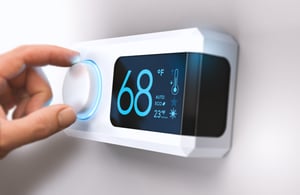 The smarter technology becomes, the smarter we can be about regulating the temperature in our homes. Thermostat control would be easy if we never left the house, but we do. We leave to go to work. We come home. We go to bed. Weekends are different, and sometimes we leave for days on end. Yet we still expect to feel comfy when we are there.
The smarter technology becomes, the smarter we can be about regulating the temperature in our homes. Thermostat control would be easy if we never left the house, but we do. We leave to go to work. We come home. We go to bed. Weekends are different, and sometimes we leave for days on end. Yet we still expect to feel comfy when we are there.
That said, no one wants to pay for too much comfort or for heating and cooling empty rooms. That’s why your thermostat is your BFF when it comes to temperature control. With the right thermostat, you can be perfectly comfortable all the time.
Stop Fiddling Around
Do you still manually set and reset your thermostat every time you leave and come home? If so, you shouldn't be! Programmable thermostats save time, and they ensure consistency — the foundation of comfy. You can set different temperatures for different parts of the day and separate days of the week, choose alternative settings for longer vacations away, etc. Set and forget.
Higher-tech thermostats now incorporate smart technology that allows you to monitor and change settings remotely or even track your energy usage. Some learn from the changes you regularly make and automatically adjust themselves in the future. And, of course, there are models that integrate seamlessly with your whole-house smart system. That’s not only efficient, it’s fun.
It’s Personal
Ultimately, you want to be comfy, or "just right," as Goldilocks said. Warm but not suffocating in winter, cool but not frigid in summer. That’s a matter of personal preference. But keep in mind that, while a degree or two may have little effect on your comfort, it can have a noticeable impact on your energy costs.
Is There A Sweet Spot?
Generally speaking, there isn’t one ideal thermostat temperature. Some like it warmer and some like it cooler – it all comes down to individual choice. The proof of that is when you and your spouse, kids, roommate, or other family members play the temperature tug of war, turning the thermostat up and down based on your ideal temp. However, to most people, a comfortable range for a summer thermostat setting when you are home is between 72-76 degrees, and it can be lower than that – between 66-72 – in the fall and winter. So, there isn’t one ‘sweet spot,’ but there is a ‘sweet range.’
Get Some Night-time Savings
You can save a lot of money on HVAC energy at night. Think about turning off your AC at night if there is less humidity and cooler temps outside. Just open windows and set up a fan to feel the breeze of fresh air. If it’s still too warm to turn off the AC at night, try supplementing a cooler AC temperature with the help of a fan and fewer blankets. Many people stay very comfortable with just a sheet.
Note: Don't leave the windows open if it's very humid outside, because it actually takes more energy to dehumidify your house than it does to heat up or cool down.
Go for Savings When You Aren’t Home
You may have heard that you shouldn’t let the temperature in your house fluctuate too much because your furnace or air conditioning will have to work overtime to re-heat or re-cool the space. Not true. The more you lower the temperature (in winter) or raise the temperature (in summer) when you’re away for at least eight hours, the more you save. About 10% off your energy bill for each degree.
For example, when you’re away for the day for work, church, errands, etc., you should turn the setting up several degrees. If it’s warm outside, anywhere between 78 or 80 degrees is fine for the 8-10 hours you’re away from home. If it’s mild out, just keep the HVAC system off.
And if you're away on vacation, you can put that setting even higher, up to 84-86 degrees or more. Even if you’re gone for just the weekend, it’s worth setting the thermostat higher.
Location, Location, Location
Your thermostat will be confused if it is mounted where it experiences sun, a drafty breeze, heat from your kitchen or fireplace, etc. To avoid an inaccurate thermostat reading, keep it away from doors, windows, and air vents. The best thermostat placement is in a central location of your home, on an interior wall, and mounted 52-60 inches above the floor.
The Human Touch Still Matters
Thermostat control starts with you. Even if you opt for the smartest high-tech controller on the market — one that can communicate with you from far away and adjust itself on the fly — it’s still up to you to identify and set your ideal temperature for different days and times. Once you show the way, your smarty pants thermostat can take over the “heavy lifting” of keeping your home comfortable.
When in doubt, trust the advice from our expert, Keith Hill, technical support manager at Minnesota Air:
“Thermostat set point is always a matter of personal preference. Within reason, ignore the numbers and set it to your comfort level.”





